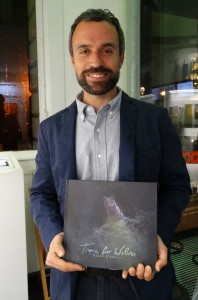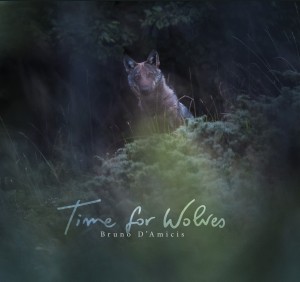For six years, wildlife photographer Bruno D’Amicis sauntered the Central Apennines mountain range of his Italian homeland in search of one the world’s most elusive animals: the wolf. This search resulted in groundbreaking and evocative pictures that document the life of wolves up-close, published in his book “Time for Wolves”. Bruno D’Amicis speaks about his book and the long quest in an interview with Rewilding Europe.

Driven by a passion for his subject and a willingness to push the limits of his patience and endurance, Bruno ended up with the most extensive collection of wolf photographs in Italy. In total, 130 of these have made it into his recently published book Time for Wolves, accompanied by evocative words that allow the reader to embark on a journey of the mind to Italy’s wild heart. Having worked with Rewilding Europe, Bruno recently took the time to speak to Arne Loth from Rewilding Europe about his book and the very special region that he calls home.
Why did you choose to dedicate six years of your professional life to photographing wolves?
More than any other animal, the wolf brings out the best in you in terms of discipline, consistency and overall vision. I have previously photographed bears and other mountain species that are quite predictable in their actions and movements. Wolves use their habitat in a much more complex way as they constantly interact with other wolves, with their prey, as well as with people. As a photographer, you are entering their territory, and they are very much aware of your presence at all times. This turns the process of photographing them into something like a game of chess in which your every move will affect the wolves’ behaviour. I very much enjoy this interplay between photographer and animal.

Could you tell us a bit more about the title of your book?
The title is a literal translation from the Italian folk expression “tempo da lupi”, which means terrible or lousy weather. It conjures up images of foggy, cold and uncomfortable days on which people are best advised to stay indoors, but which are thought to be perfect conditions for wolves to come out and hunt. I wanted to turn this expression on its head and take “tempo da lupi” quite literally, in the sense of finding time in your life to get to know and learn about wolves. Modern life is full of responsibilities and many of us are so busy checking our phones or answering emails that entire days can go by just trying to stay on top of our everyday duties. Observing wolves is an exercise that teaches us to take some time out and immerse ourselves in the natural world without worrying about any time frames or deadlines. It is time well spent, and I want to encourage people to allow themselves to experience these precious moments of tranquility in a hectic and demanding world.
What makes the Central Apennines such a special place?
I find it absolutely fascinating that you can spend the morning seeing the sights of Rome, get in a car and find yourself in the middle of wolf and bear country an hour later. I live in the Central Apennines and have dedicated myself to understanding its intricate ecosystem and to protecting it for future generations. The wolves have been a teacher for me in a way, as they have allowed me access to their home and have given me a unique insight into this precious place.

Is there a specific message that you want people to take away from the book?
The overall message is one of respect and understanding. We need to realise that these wolves have been carving out a secret existence in the shadows for millennia, surviving despite a long history of persecution by humans. This is a reminder that, in Europe, wolf conservation is very much a cultural issue. If we want to protect these amazing animals on our densely populated continent, we have to look beyond their ecological function and address the role they could play in contemporary society. Wolf conservation in Europe is an exercise in tolerance and coexistence, and I want to encourage my readers to take part in this journey. Taking “time for wolves” will not only help people find some peace and tranquillity, but it will also give them a new perspective on life by attempting to see the world from the wolves’ eyes. It is a win-win for us as well as for the animals, and I hope that my book can make a small contribution towards this.
Time for wolves is available in hardback from Bruno D’Amicis website. You can find out more about our work in the Central Apennines rewilding area , including many of Bruno’s images here. To always be in the know about what is happening throughout our rewilding areas, sign up to our newsletter by scrolling down to the box below.
